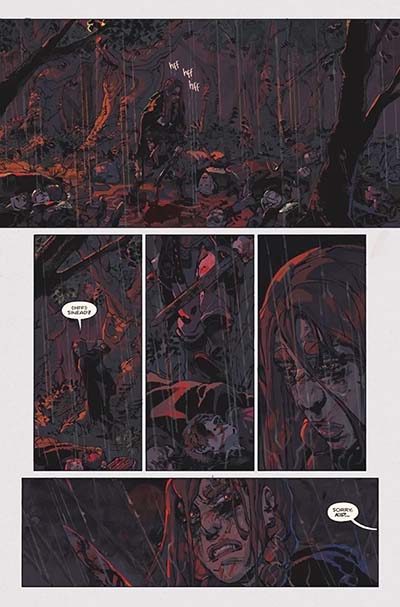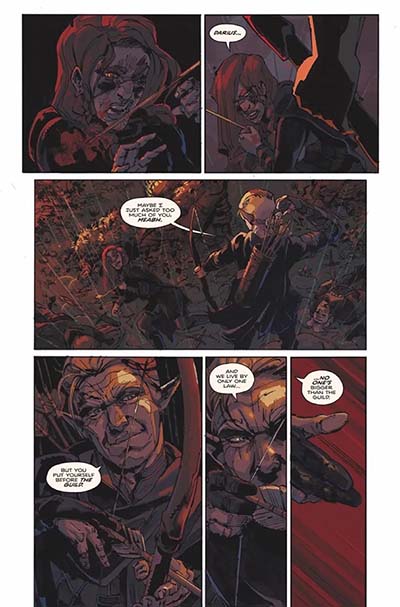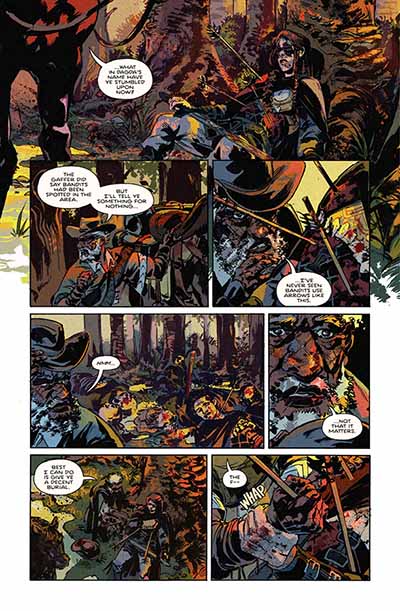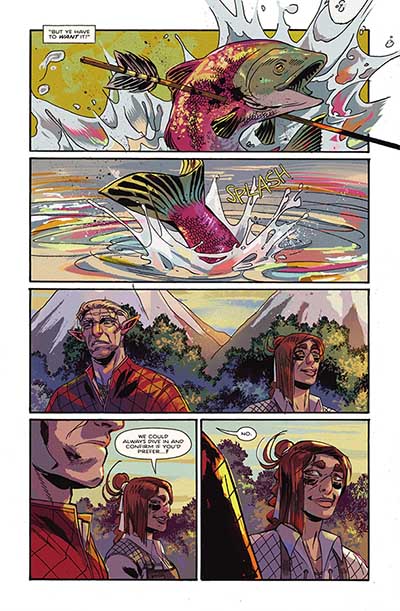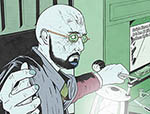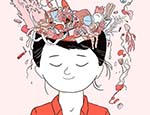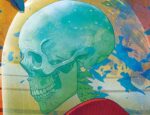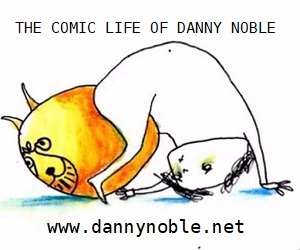Described as “a tragic tale of loss and redemption” by publishers Mad Cave Studios fantasy series When the Blood Has Dried follows the story of Meabh of Cklonia, a small town tavern owner with a darker past that threatens to reveal itself when a branch of the Adventurers Guild arrives. Writer Gary Moloney talks to BF’s Ellie Egleton about redemption and forgiveness, fantasy in comics, and how to build your profile as an aspiring comics creator…
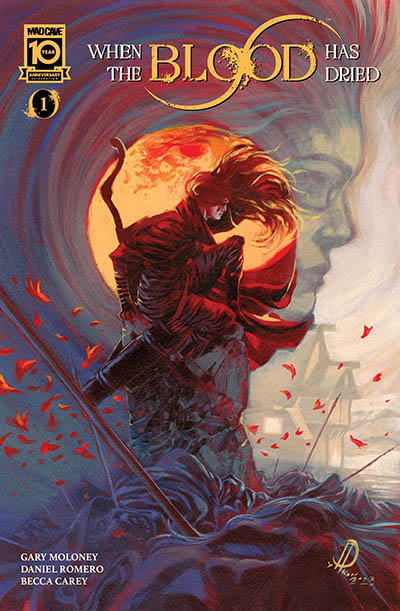
BROKEN FRONTIER: Gary, thank you so much for agreeing to do an interview with us here at Broken Frontier. Following from your previous work at Limit Break Comics, your new series When the Blood Has Dried has made its debut at Mad Cave Studios. The story sees the adventurer, Meabh of Cklonia, settle for a quiet life running a local pub called the ‘Lough Inn’. It is a fantasy with an Irish tinge. Can you please tell us a little bit about the inspiration behind the book?
GARY MOLONEY: Hi Ellie, thanks for having me. The series really grew from my first experiences with TTRPGs. Growing up, I was always a reader and epic fantasy is a genre I’ve a particular love for. I’m not sure you could be a child of the 90s, see the original Lord of the Rings trilogy in theatres and not have a love of that material. And, of course, those films brought with them a renaissance in epic fantasy as a whole. Suddenly you had this new wave of fantasy books and series to get swept up in. My tastes in fantasy changed over time, I was drawn more towards urban fantasy series like The Dresden Files over more traditional epic fantasy which I’d begun to find a bit stale and same-y. I never stopped reading the genre totally though and whenever I came across a really good author like Joe Abercrombie, I’d devour their work. For a long time, I just felt burnt out on epic fantasy unless it offered something new or interesting.
You’d think with that background that I’d have always been into the likes of Dungeons & Dragons but it wasn’t as common as wargaming was where I lived. So, I played the Lord of the Rings miniatures games, dabbled in a bit of Warhammer, and played video games like Dragon Age but TTRPGs weren’t something I was really exposed to. You’d see them in some comic shops but this was prior to the boost that the hobby got after the release of Fifth Edition, no one I knew was into it, and there weren’t many clubs for people to attend (or if there were I wasn’t aware of them).
Then after finishing my Masters, I moved to Dublin to start my first real job. As I was finding my feet in the city, an old friend of mine invited me to join his Dungeon & Dragons game. Everyone in the group was new to role-playing and he wanted to run the Lost Mines of Phandelver Starter Set. It started just as an excuse for us all to meet up and have a few drinks but it wasn’t long before we’d caught the bug.
In the process of playing that first campaign, I began to realise what made D&D different from other fantasy stories I’d experienced before. That was the idea of your characters as the journeymen adventurers. Players aren’t typically figures of myth or legend. They’re not the chosen one. It’s not their job to bring balance to the Force or dethrone the Dark Lord. Their concerns are much smaller in scale. They’re looking for their next pay cheque or to survive the night or settle a personal score. Playing D&D made me realise that your fantasy could still be epic while keeping your stakes grounded.
From there, and looking at the typical D&D party as journeymen (or “Murder Hobos” as some within the community refer to them), I began to see that term “adventurer” as just a nice way of saying “mercenary” because at the end of the day that’s what you were. And I thought, wouldn’t it be interesting to really play into that. To ask what a lifetime of playing the hero would do to a person when they knew in their hearts they really anything but. That’s when this image came to me of a retired adventurer, tending bar, trying to put their old life of violence behind them. A high fantasy with a spaghetti western flavour and, perhaps most importantly as you mentioned, this Irish sensibility.
BF: Is the protagonist, Meabh of Cklonia, inspired by any real-life figures? And with a complex past as a member of the mysterious guild, how did you approach developing her character arc from a ruthless sell-sword to a beloved barkeep?
MOLONEY: I wouldn’t say that Meabh is based on any real-life figures per se. Irish history and folklore is full of these women in position of powers that would normally be dominated by men. You’ve got Gráinne Mhaol, the infamous pirate queen whose name people love to butcher, or Queen Meadhbh of Connacht best known for her role in An Táin Bó Cúailnge (Ireland’s equivalent to The Iliad) but other than the latter’s name there was no direct inspiration.
As for the balancing act of developing this character with such a brutal and violent past into someone who had come to embrace the peaceful life? Well, that’s what interested me the most. I’ve found that I’m very interested in examining cycles of violence in a lot of my work. They’re things that will eat you up one way or another. Either you become a victim to it yourself or you lose yourself in the process. So, with Meabh, I wanted to explore what happens when someone has the courage to break that cycle and show the really gruelling nature of the journey that follows. I think in a lot of fiction you see someone like Meabh turn from that darker path and all is forgiven in relatively short order. But that’s not how things work most of the time.
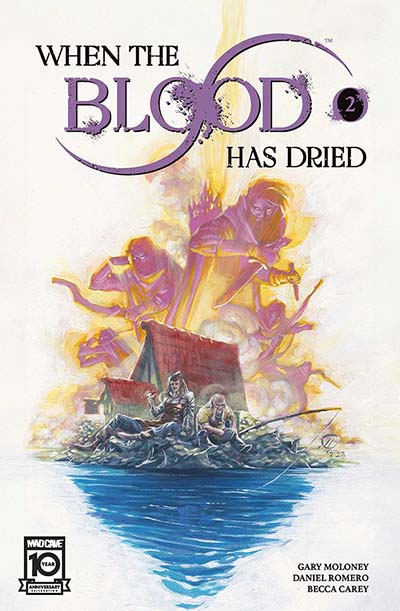
Deciding to leave the Guild was the easy part, it’s what comes next that’s harder. There are some things that you can’t expect forgiveness for. Some things that you can’t come back from in the eyes of others. But life goes on. You have to find a way to move on in the absence of forgiveness. To try to live a better life and hope that is enough. It’s not that Meabh has forgotten her past but she’s trying not to let it control her future and the person she is now. That’s why a character like Traolock, Meabh’s mentor and the previous barkeep, is so important. Because he helps to show her that such a path is possible and that she doesn’t have to succumb to the allure of vengeance.
BF: Can you talk about the town of Carraig an Bhun? How does the Southern Territories contribute to the overall narrative of When the Blood Has Dried?
MOLONEY: Carraig an Bhun is really a character of itself in our book and we don’t venture too far from it throughout the series. It’s why spend so much time in our first issue introducing you to the place and its denizens. We designed it really to replicate the kind of small, rural villages that I grew up around in Ireland. A place where everyone knows everyone and gossip is a premium currency. We wanted our readers to fall in love with Carraig an Bhun early on because if they see what Meabh finds it all so special then they will be more likely to be invested when her place in the village is threatened by the Guild’s arrival.
But there’s also the darker side of places like Carraig an Bhun. The sense someone who has lived in the village for years will always be considered an outsider or a “blow-in” as we refer to them. No matter how welcome you might be, there’s always a condition to that welcome. And that’s what makes Meabh’s role so precarious.
Insofar as the Southern Territories as a whole are concerned, that’s the broader setting of countries or nations that the story takes place in. One of the things that really sells me on a fantasy series is the feeling that the characters are inhabiting a lived-in world, that there are events and lives happening off-screen which we may not be privy to but are no less important. So, when Daniel and I were developing the setting, we wanted to make sure that we had some sense of the wider political structures and players even if they wouldn’t appear in the series itself. Daniel in particular did a lot of design and concept work with that in mind.
That’s why we refer to the prospect of another war on the horizon, the threat emerging from the East, and the Guild’s status as a paramilitary wing of the State. It’s because those are things which may impact our characters’ lives even when the nature of the story is that it’s confined to this one smaller location. It allowed us to speak about those things with authority and ensure that our readers didn’t feel like these were ideas or places that only came into existence as we needed them. It’s also what will allow us to return to this world should we choose to do so down the line!
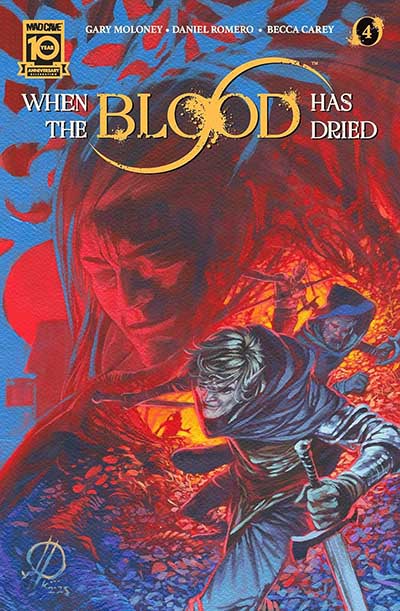
BF: Redemption and dealing with one’s past are central themes in your comic. What message do you hope readers take away from Meabh’s story?
MOLONEY: Nobody owes you their forgiveness. Redemption isn’t an arc you complete at the end of the season. It’s something you work towards each and every day of your life. Something that’s thankless and often unrewarding of itself. An ideal you’ll strive towards knowing you’re going to stumble sometimes. But you do it anyway. Because it’s in the striving that you become worthy of it and become the person you want to be.
BF: Am I right in thinking that this is not the first time you have collaborated with artist, Daniel Romero? How far back does your partnership go and are you both pleased with the response from readers for your new book so far?
MOLONEY: Daniel is, in fact, one of my oldest collaborators in comics. We began working together all the way back in 2018 when I was putting my first self-published collection of short stories. We met on a forum dedicated to matchmaking artists and writers where we hit it off straight away. I could see his passion and his drive for storytelling. We both had similar sensibilities and taste. It just felt right even from our earlier projects together. That’s part of what has made this book such a joy to work on. I’ve got to do it with someone who was there with me from day one, who came up in the industry with me, and who has always been one of my biggest supporters.
We’re immensely pleased with how the book has gone down with readers. We’ve been working on this book in one shape or form for the last four years so to have it finally out there and seeing it find its audience has been so rewarding. Fantasy seems to have had a bit of a renaissance in comics this year, so the fact that there are people who appreciate what we’re doing and the particular type of story we’ve been trying to tell, it’s been amazing. What I’m most excited for right now is to see what the people who discover it in the trade paperback think and how they view the experience as compared to the single-issue readers. I think that’ll be very interesting.
But, ultimately, if the biggest thing people take away from When the Blood Has Dried is that Daniel Romero deserves to be drawing more comics then I’ll be happy enough with that. It’ll all have been worth it.
BF: Without giving too much away, can you hint at any future projects that you might have coming up? Either set in the world of When the Blood Has Dried or others?
MOLONEY: There’s a lot that’s still TBA and I wouldn’t want to risk jinxing any of it but I’m working on a number of projects both in and outside of comics. Some of those are original stories are others are work-for-hire project for characters and universes that I’ve loved all my life. The key ones at the moment are my ongoing work on the Irish language version of Dan Schkade’s Flash Gordon trip and the upcoming Kickstarter for Wish Upon A Star, the Far Future Fairytale anthology that I’m co-editing with Paul Carroll for Limit Break Comics (which re-launches on 18th September).
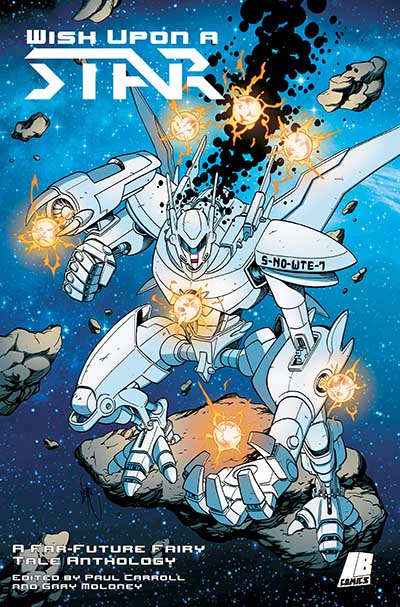
Cover art by Nate Stockman & Dee Cunniffe
As for whether we will see more from Meabh, Fergus, and the gang, I’ve always said that while When the Blood Has Dried was always conceived as a standalone story with a definitive arc and hopefully a satisfying end for our characters that I would love to return to explore different parts of this world. But that’s down to the readers at the end of the day. So, if you’re interested in more, then let Mad Cave know and consider picking up the trade paperback when it releases on 19th November.
I can say in that regard that we’ve worked with the wonderful game director and writer, Anton Kremoff, on an 5e compatible supplement for When the Blood Has Dried called The Tools of the Traitor which will be launching alongside the trade paperback. It’s a wonderful one-shot adventure that will allow players to explore the world of WTBHD as members of the Guild as they are each summoned to answer its call.
BF: Comics are such an exciting medium. How did you discover your love for comics? And do you have any books in your current reading pile?
MOLONEY: Would you believe me if I said it was Sonic the Hedgehog? I was a huge fan of Fleetway’s Sonic the Comic back in the day. It was essentially baby’s first dystopia and I was obsessed with the storytelling in that book from Richard Elson’s Sonic to the late Nigel Dobbyn’s Knuckles (and, of course, those brilliant Mick McMahon strips). From there, I move onto Panini’s Marvel reprints of Ultimate Spider-Man and the rest of history!
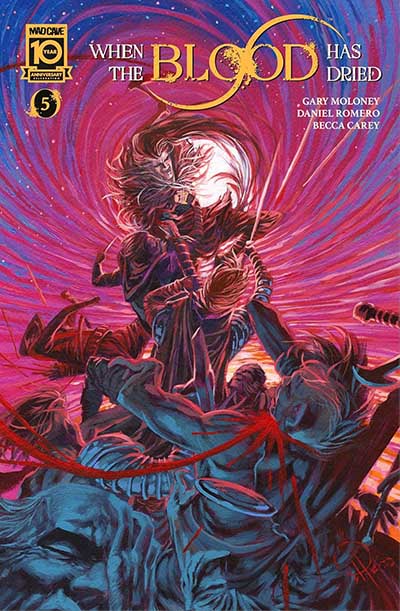
I’m reading far too many books as it is between manga and regular comic titles. My TBR pile violates several building regulations and is at risk of crushing me even as I type this. I’ve been hugely impressed with the Conan the Barbarian relaunch that’s been spearheaded by Jim Zub and Robert De a Torre over at Titan/Heroic Signatures. They’re really pushing back at a lot of the assumptions we’ve made about sword and sorcery comics over the last twenty years. Liam Johnson has been doing some brilliant work over in the Judge Dredd Megazine with Armitage in recent months. I think everyone should be following the work Colin Craker is doing on his Agency Case Files series and his forthcoming work on Terminator for Dynamite. I also just finished reading a preview of The Exorcism at 1600 Penn written by my friend Hannah Rose May with Vanesa Del Ray on art duties, Jordie Bellaire on colours, and Hassan Otsmane-Elhaou on letters. That’s such a provocative book to be releasing during an election year in the US and I think it’s one people are going to want to be keeping an eye on.
BF: What is the best advice you can give to those looking to make comics?
MOLONEY: Hire a good letterer. Sorry, that’s one blatantly stole from P.J. Holden’s comic creation class. But, really, I think the best advice I can give is to stop waiting for permission and start making comics. Put your work out there and be willing to fail in public. Start small with four-page stories in the Future Shock vein. Practice and build your craft that way. Find out what works for you and what doesn’t. Explore where you interest lies. Not only will you build yourself a portfolio of work you can show to editors but you’ll make sure that you’ve polished your skills enough so that when an opportunity lands on your lap to pitch or to submit a story for publication, you’re ready to take advantage of it. Don’t wait for someone to offer you your perfect project, sometimes you’ve got to make it yourself.
Discover more about When the Blood Has Dried on the Mad Cave site here
Interview by Ellie Egleton





